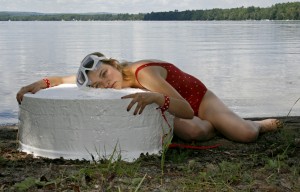Dulcified Art: An Interview with Food Artist Caitlin Berrigan
She floated on an over-sized marshmallow while singing “American Pie,” wore a dress made out of prosciutto (before Lady GaGa), and made ice cream from human breast milk.
Welcome to the strange world of Boston-based artist Caitlin Berrigan who specializes in integrating performance with edible art.
The young artist has had numerous national and international showings, including one at the 2010 Vancouver Olympics, and has held art residencies in the U.S. and Berlin. She has been an invited speaker at the New Museum and Harvard Medical School.
Her most recent project, Spectrum of Inevitable Violence, maps out class status, economic status, mobility and cultural capital in an effort to depict the institutionalization of socioeconomics.
However, Berrigan’s quirky sense of humor can be found even in the most serious projects.
Last year’s installation of Spectrum of Inevitable Violence ended in a mass food fight.
A few months ago, Berrigan collaborated with fellow artist Anya Liftig in this year’s Art in Odd Places festival. Their project, Adoring Appetite, explored the politics of motherhood. During the festival, she and Liftig could be found wandering the High Line devouring babies made out of fudge.
In an interview with GALO, Berrigan talks about what goes into creating her art, her methodology, and her 100-pound marshmallow.
GALO: What inspired you to incorporate food into your art?
Caitlin Berrigan: I actually started doing things with honey. A lot of that had to do with the pleasure, the viscosity, weight and color, and then later, the material itself. The kind of material history of food is always present in the work that I do.
GALO: The last time I talked to you was before your Adoring Appetite performance at Art in Odd Places. How did it go?
CB: We had a lot of mixed reactions which was fantastic.
GALO: Did it take people a while to realize what was going on?
CB: Sometimes, yeah. If they would look at us they would know that [the babies] weren’t real. But a lot of people said that they would catch us out of the corner of their eye and just kind of thought that we were “whatever mommies.” And then a lot of people did double takes once they kind of visually registered what was going on.
GALO: Would you say you have a repeating message in your work?
CB: My work is not necessarily topical all the time. I think, more, that I’m just interested in unsettling people’s boundaries in different ways. And I guess in that sense a lot of it has to do with different power issues and issues of social responsibility–assuming the ways that we are socialized. A lot of [my projects] have to do with social politics and economies, but there is no uniting topical social thing or anything. I think that, mainly, it’s just sort of a methodology of working that I practice.
GALO: How did you make the marshmallow for the Marshmallow Suicide?
CB: I was at the Skowhegan residency in Maine, and there the kitchen staff was kind enough to let me use the kitchen — their industrial kitchen. So I used their industrial mixer and everything and made a gigantic batch of marshmallow–and had a huge mold that we made out of cardboard and aluminum in the fridge–and just made several layers of marshmallow. It took about a week, and it used about 75 pounds of sugar, or something like that. And corn syrup — a few gallons of corn syrup. So the whole thing in the end weighed about 100 pounds. It weighed more than I do.
GALO: So how long did you have a stomachache after that?
CB: Actually, the worst part was the cavities.
GALO: How would you say your art has developed?
CB: I think that I’ve learned a lot about participation and audiences. What you can expect from them and how to engage audiences. I have a lot of respect for my audiences. I don’t take them for granted. […] I really try to work into all of the work that I do some kind of an atypical exchange with people. I’m trying not to engage in lonely work that just puts itself out there as a thing and people can take it or leave it. But I really try to figure out this complex relationship with the audiences in different forms.
For more on Caitlin Berrigan, visit caitlinberrigan.com.


